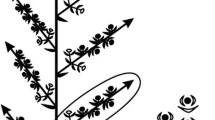Abstract
The structure and ontogeny of the foliage leaves, bracts, bracteoles, calyx and corolla ofPharbitis nil were investigated, with special reference to the development of the lamina and the procambium. Reproductive organs used are those of a terminal inflorescence and axillary flowers induced by a single 16 hr dark period given to the seedling. The foliage leaf consists of the petiole and the broad lamina. Bracts show various forms and structures, which fluctuate from a lower leafy bract to an upper scaly one in a terminal inflorescence. The sepal is scaly. The corolla is funnel-shaped, and composed of five wedge-shaped petals.
In the lamina of the foliage leaf primordium, marginal growth is followed by active growth by the plate meristem, and procambial strands of lateral veins differentiate from the residual meristem. The primordium of the lowest bract of the terminal inflorescence has already been initiated before the dark period, and develops into the bract, the residual meristem disappearing after the treatment. The leafy bract shows marginal growth and growth by the plate meristem similar to that of the foliage leaf, but of short duration. The activity of marginal growth of the scaly bract and the sepal decreases rapidly and procambial strands of lateral veins differentiate acropetally from highly vacuolated cells. The activity of marginal growth of the petal decreases gradually, and derivatives of the marginal meristem divide as a plate meristem. The corolla tube is initiated by co-operation of interprimordial growth and marginal growth of petal primordia.
Similar content being viewed by others
References
Bhar, D.S. 1970. In vitro studies of floral shoot apices ofPharbitis nil. Can. J. Bot.48: 1355–1358.
— andN.W. Radforth 1969. Vegetative and reproductive development of shoot apices ofPharbitis nil as influenced by photoperiodism. Can. J. Bot.47: 1403–1406.
Boke, N.H. 1948. Development of the perianth inVinca rosea L. Amer. J. Bot.35: 413–423.
Cusick, F. 1966. On phylogenetic and ontogenetic fusions, pp. 170–183.In: E. G. Cutter ed., Trends in Plant Morphogenesis. Longmans, London.
Esau, K. 1965. Plant Anatomy, 2nd ed. John Wiley and Sons, New York.
Foster, A.S. 1936. Leaf differentiation in angiosperms. Bot. Rev.2: 349–372.
Gifford, E.M., Jr. 1951. Early ontogeny of the foliage leaf inDrimys winteri var.chilensis. Amer. J. Bot.38: 93–105.
— 1963. Developmental studies of vegetative and floral meristemsIn: Meristems and Differentiation. Brookhaven Symposia in Biology16: 126–137.
Hara, N. 1957. On the types of the marginal growth in dicotyledonous foliage leaves. Bot. Mag. Tokyo70: 108–114.
Healey, P.L. 1964. Histochemistry and ultrastructure in the shoot ofPharbitis before and after floral induction. Ph. D. dissertation, Univ. of Calif., Berkeley.
Imamura, S. ed. 1967. Physiology of Flowering inPharbitis nil. Japan. Soc. of Plant Physiol., Tokyo.
Kaplan, D.R. 1967. Floral morphology, organogenesis and interpretation of the inferior ovary inDowningia bacigalupii. Amer. J. Bot.54: 1274–1290.
— 1968. Structure and development of the perianth inDowningia bacigalupii. Amer. J. Bot.55: 406–420.
Marushige, Y. 1965a. Ontogeny of the vegetative and reproductive apices inPharbitis nil Chois. I. Development of the vegetative apex. Bot. Mag. Tokyo.78: 353–359.
— 1965b. Ontogeny of the vegetative and reproductive apices inPharbitis nil Chois. II. Development of the terminal flower bud. Bot. Mag. Tokyo.78: 397–406.
— 1965c. Ontogeny of the vegetative and reproductive apices inPharbitis nil Chois. III. Development of axillary buds. Bot. Mag. Tokyo.78: 407–411.
Sattler, R. 1973. Organogenesis of Flowers. A Photographic Text-Atlas. Univ. of Toronto Press, Toronto.
Tepfer S.S. 1953. Floral anatomy and ontogeny inAquilegia formosa var.truncata andRanunculus repends. Univ. Calif. Publ. Bot.25: 513–648.
Tucker, S.C. 1959. Oncogeny of the inflorescence and the flower inDrimys winteri var.chilensis. Univ. Calif. Publ. Bot.30: 257–336.
Wada, K. 1968. Studies on the flower initiation inPharbitis seedlings, with special reference to the early stimulation of cell division at the flower-induced shoot apex. Bot. Mag. Tokyo81: 46–47.
Author information
Authors and Affiliations
Rights and permissions
About this article
Cite this article
Nishino, E. Developmental anatomy of foliage leaves, bracts, calyx and corolla inPharbitis nil . Bot. Mag. Tokyo 89, 191–209 (1976). https://doi.org/10.1007/BF02488342
Received:
Issue Date:
DOI: https://doi.org/10.1007/BF02488342




